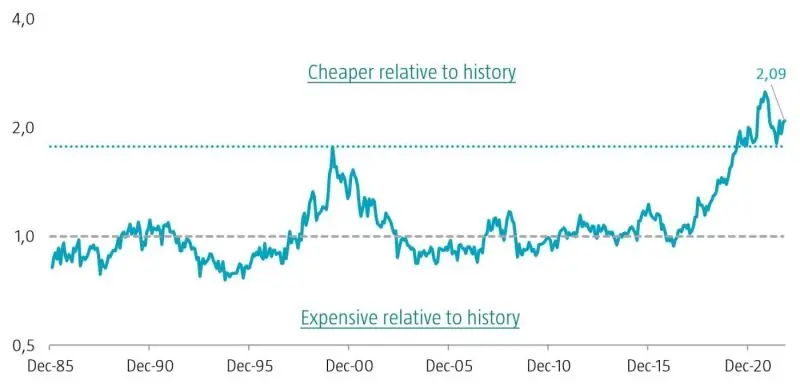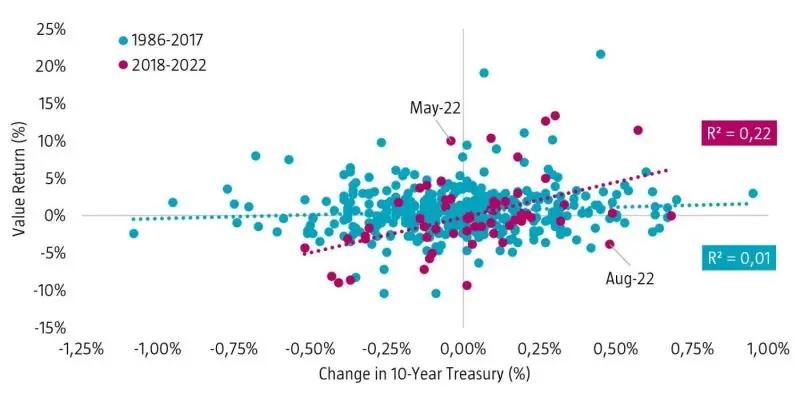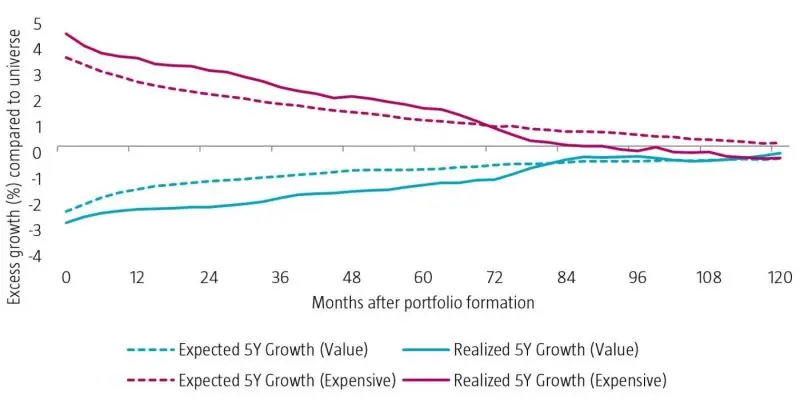The poor performance delivered by value strategies from 2018 to 2020 was accompanied by an extreme widening of valuation multiples between value and growth stocks, with the former getting cheaper than the latter. But the solid recovery over the last two years could perhaps leave some investors wondering whether the value style is now less attractive.
Value factor remains relatively cheap in historical terms
In Figure 1 we show the valuation spread of the value factor,1 meaning the differences in valuation multiples of value and growth stocks.2 As we control for valuation differences that are normally observed between both portfolios, a valuation spread that is above one indicates cheapness, while a reading below one implies that the factor is relatively expensive.
Figure 1 | Composite valuation spread of the enhanced Value factor

Source: Robeco, Refinitiv. The chart shows the composite valuation spread between the top and bottom quintile portfolios of the enhanced value strategy. The investment universe consists of constituents of the MSCI Developed and Emerging Markets indices. Before 2001, we use the FTSE World Developed index for developed markets (going back to December 1985), and for emerging markets, the largest 800 constituents of the S&P Emerging BMI at the semi-annual index rebalance (going back to December 1995). The value spread is the average spread of the book-to-market (R&D adjusted), EBITDA/EV, and CF/P. The sample period is January 1986 to October 2022.
Interestingly, the spread has only shrunk slightly during this period. More specifically, it is still wider as at the end of October 2022 than it was at the beginning of the value winter in 2018. To put things into perspective, the current spread is even wider than it was at the peak of the dot-com bubble in 2000.
Furthermore, value is not only cheap from a relative perspective, but also on an absolute basis as it trades at a forward price-to-earnings ratio (PE) of slightly above 8x. Therefore, the medium-term return expectations for Value are bright, especially if valuations revert to ‘normal’ levels (more on this in the full article).
Despite the strong recent recovery, the value factor is still cheaper than it was at the beginning of its drawdown. This is because, while changes in the value spread explain a large portion of the value returns, they do not explain them entirely. The remaining variation stems from three components: namely carry, portfolio migration and changes in fundamentals (these are discussed in detail in the full article).
Value is not just a beneficiary of rising yields
A popular question is whether the latest rise in interest rates caused the recent value comeback. In our 2021 article,3 we already investigated this notion and documented that while the relationship has been evident recently, it is much weaker over the long run and for longer-return horizons. In this section, we revisit this issue but approach it in a less technical way.
Figure 2 illustrates the relationship between US value returns and contemporaneous changes in the US 10-year Treasury yield. The chart confirms our previous research results as we find little to no evidence that the value factor correlates to interest rate changes for the period spanning from January 1986 to December 2017. However, the correlation has been higher over the last five years.
Figure 2 | Value returns and interest rate changes

Source: Robeco, Refinitiv, FRED. The chart shows the relationship between U.S. value returns and contemporaneous changes in the U.S. 10-Year Treasury yield. The investment universe consists of U.S. constituents of the MSCI Developed Market Index. Before 2001, we use the FTSE World Developed Index (going back to December 1985). The sample period is January 1986 to October 2022.
But even in recent years, the relationship has been far from perfect. In fact, changes in interest rates explain only a small fraction of the variation in the value returns. Interestingly, the last few months indicate that the relationship may have weakened again. For instance, May 2022 was an excellent month for value while yields slightly decreased, whereas August 2022 was a rather bad month for the factor even though interest rates increased by nearly 50 basis points.
Based on this analysis, we believe that the relationship between value returns and interest rates is not structural – or causal – but more a temporary phenomenon that might well provide some tailwinds for value in the months ahead. However, while the positive relationship between value and yields might persist for some time, possibly due to some self-fulfilling prophecy, we do not believe that interest rates will be the decisive factor for value in the years ahead.
Growth stocks do not necessarily have higher future growth
One reason many investors might believe that interest rates drive the returns of the value factor could be based on the argument that growth stocks exhibit longer duration than their value counterparts. Therefore, they should benefit from a lower discount rate being applied to their cashflows and suffer from rising yields.
We acknowledge this line of reasoning but believe that the relationship is ambiguous, meaning one could argue that value stocks are ‘bond-like’ as their prices are driven less by growth expectations and more by their earnings and dividend power in the years ahead. This would imply a negative relationship between value returns and interest rates.
That said, we looked into whether expensive stocks really do have higher future growth. In our analyses, we sort stocks based on valuation multiples and not on past or expected growth. And while companies with high historical growth in sales or earnings typically trade at higher multiples, future long-term growth is much harder to forecast.
Figure 3 depicts the previous five-year realized growth in earnings and analysts’ long-term (five-year) earnings per share (EPS) growth expectations at portfolio formation (t=0), and up to ten years (t=120) after this for the cheap (‘value’) and expensive (‘growth’) quintile portfolios versus the universe. The chart shows that the spread for both historical growth and growth expectations between value and expensive firms is indeed highest at portfolio formation.
Figure 3 | Realized and expected earnings growth for Value quintiles after portfolio formation (AC)

Source: Robeco, Refinitiv, I/B/E/S. The chart shows the previous 5-year realized growth in earnings and the long-term (5-year) EPS growth expectations of analysts for the top (value) and bottom (expensive) quintile portfolios of the enhanced value strategy at portfolio formation (t=0) and up to ten years (t=120) after portfolio formation. For each measure and month, we compute the median for both the cheapest and most expensive quintile and deduct the universe median. The investment universe consists of constituents of the MSCI Developed and Emerging Markets indices. Before 2001, we use the FTSE World Developed index for developed markets (going back to December 1985), and for emerging markets, the largest 800 constituents of the S&P Emerging BMI at the semi-annual index rebalance (going back to December 1995). The sample period is January 1986 to October 2022.
Analysts expect expensive companies to generate about 4% higher EPS growth than the average company, while value firms are expected to deliver around 2.5% lower growth. These numbers are remarkably similar to the realized growth numbers that the two groups of stocks achieved over the five years before portfolio formation. Therefore, it seems that analysts extrapolate past growth into the future.
This difference in growth expectations is a key reason why investors are willing to pay a higher price for growth firms. However, these differences are not persistent. As shown in the chart, the spread in both growth expectations and realized growth rapidly converges in the years after portfolio formation, with value stocks experiencing improvements in growth realizations and expectations, whereas their expensive peers encounter deteriorating growth realizations and expectations.
After eight years, we see that the actual difference is less than 1%. Therefore, investors appear to be overpaying for the expected growth differences at portfolio formation, as analysts and other market participants extrapolate historical growth too far into the future. In other words, realized growth does not live up to expectations. As a result, we view these converging growth expectations as one of the driving forces behind the value premium.
Read the full articleFootnotes
1 We define value as in Blitz, D. C., and Hanauer, M. X., January 2021, “Resurrecting the value premium”, Journal of Portfolio Management. More specifically, the enhanced value strategy is based on a composite of book-to-market (R&D adjusted), EBITDA/EV, CF/P, and NPY metrics. Value stocks are sorted into quintile portfolios based on the valuation composite, in a region and sector neutral manner for developed markets and in a country neutral manner for emerging markets. Quintile portfolios are equal-weighted and rebalanced monthly. Our sample comprises the standard MSCI All Countries Index constituents, i.e., large and mid-cap stocks across both developed and emerging markets.
2 The ‘value spread’ is expressed as the ratio of a basket of valuation multiples of the top and bottom quintile value portfolios. We control for value spread differences that are normally observed between both portfolios, such that a value spread above one indicates cheapness. Since cheap stocks by definition have higher fundamental value to price ratios than their expensive peers, it is particularly important for the value factor to scale the value spread by its historical normal level.
3 Baltussen, G., Hanauer, M. X., Schneider, S., and Swinkels, L., September 2021, “What valuations and interest rates tell us about equity factors”, Robeco article.
クレジットに関する最新の「インサイト」を読む
ロベコのニュースレター(英文)に登録し、最新のインサイト記事をいち早くご覧ください。環境に配慮したポートフォリオ構築にも役立つ情報をお届けします。
重要事項
当資料は情報提供を目的として、Robeco Institutional Asset Management B.V.が作成した英文資料、もしくはその英文資料をロベコ・ジャパン株式会社が翻訳したものです。資料中の個別の金融商品の売買の勧誘や推奨等を目的とするものではありません。記載された情報は十分信頼できるものであると考えておりますが、その正確性、完全性を保証するものではありません。意見や見通しはあくまで作成日における弊社の判断に基づくものであり、今後予告なしに変更されることがあります。運用状況、市場動向、意見等は、過去の一時点あるいは過去の一定期間についてのものであり、過去の実績は将来の運用成果を保証または示唆するものではありません。また、記載された投資方針・戦略等は全ての投資家の皆様に適合するとは限りません。当資料は法律、税務、会計面での助言の提供を意図するものではありません。 ご契約に際しては、必要に応じ専門家にご相談の上、最終的なご判断はお客様ご自身でなさるようお願い致します。 運用を行う資産の評価額は、組入有価証券等の価格、金融市場の相場や金利等の変動、及び組入有価証券の発行体の財務状況による信用力等の影響を受けて変動します。また、外貨建資産に投資する場合は為替変動の影響も受けます。運用によって生じた損益は、全て投資家の皆様に帰属します。したがって投資元本や一定の運用成果が保証されているものではなく、投資元本を上回る損失を被ることがあります。弊社が行う金融商品取引業に係る手数料または報酬は、締結される契約の種類や契約資産額により異なるため、当資料において記載せず別途ご提示させて頂く場合があります。具体的な手数料または報酬の金額・計算方法につきましては弊社担当者へお問合せください。 当資料及び記載されている情報、商品に関する権利は弊社に帰属します。したがって、弊社の書面による同意なくしてその全部もしくは一部を複製またはその他の方法で配布することはご遠慮ください。 商号等: ロベコ・ジャパン株式会社 金融商品取引業者 関東財務局長(金商)第2780号 加入協会: 一般社団法人 日本投資顧問業協会


